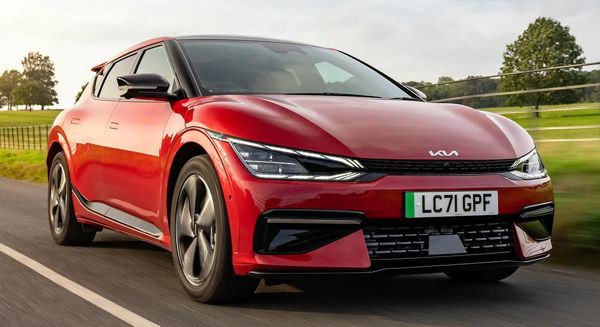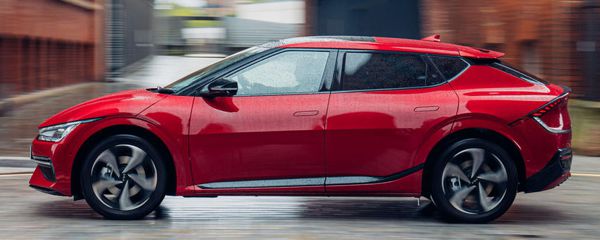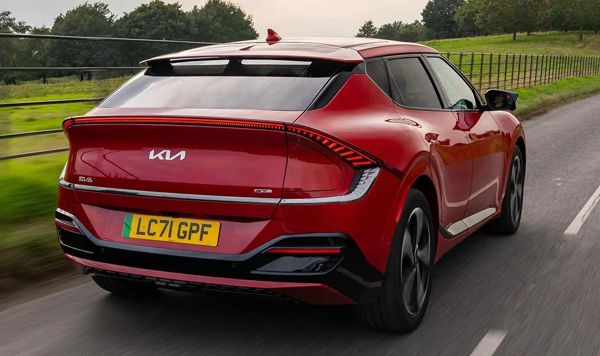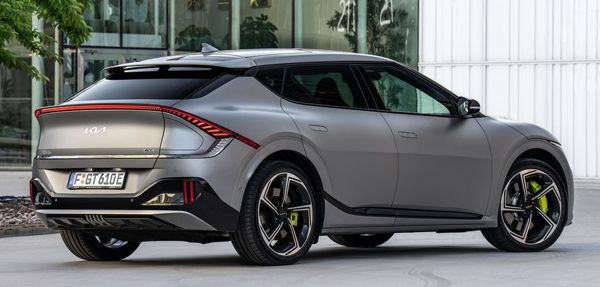Published
on 30
Oct 2021
|
All rights reserved.
|
|
|

|
|
A
credible alternative to Tesla Model 3, or even a BMW 3-Series.
|
|
The new age of EV not only
benefits startups like Tesla but also gives mainstream car makers like
Hyundai-Kia group a great opportunity to move upmarket. Just a few
years back, no one could imagine the Korean to break into the
premium car segments long dominated by the German. While Kia Stinger
and Hyundai’s Genesis show promising signs, in general they are still
not great enough to persuade buyers switching from their default
choices of BMW, Mercedes and Audi. However, when everybody abandons
combustion powertrains and moves towards electric power, they are
pretty much on level playing field. The German car maker’s superior
know-how in mechanical engineering becomes useless. Instead, Korea’s
expertise in
electronics, battery and information technology rise to the center
stage. In addition to the new-found design supremacy shown by
Hyundai-Kia group since they recruited Peter Schreyer, Luc Donckerwolke
etc., it is not a surprise to see that they are able to build better
and more desirable EVs than any German car makers. Yes, I mean Hyundai
Ioniq 5 and Kia EV6.
Before these cars, Hyundai-Kia already built some nice EVs in the form
of Ioniq Electric, Kona Electric, Soul EV and Niro EV. However, the
Ioniq 5 and EV6 are the first built on E-GMP, the group’s first
dedicated EV platform. It goes without saying this is a skateboard
platform, with all battery modules placed at the floorpan within
wheelbase so to make possible a flat cabin floor and large cargo space
while achieving low center of gravity and 50:50 balance, not to mention
the possibility
of installing 1 or 2 motors. It is not exactly a ground-breaking idea,
but what Hyundai and Kia succeed is the execution. Let’s put it
straight, the Korean duo are credible alternatives to Tesla Model 3.
They are stylish. They are well-built. They are spacious. They are
quick. They drive nicely. They travel long. They recharge quickly. They
are the best yet challengers to Tesla, and in many ways better than it.
Most important, for the first time ever, you won’t feel painful to
trade a new BMW 3-Series with either Korean EVs. Yes, they are nearly
that good.

|
|
Kia has done as
much as it can to make the car look sporty.
|
|
Style-wise, I prefer the Hyundai for its Lancia Delta looks. However,
the Kia is also very stylish. Its combination of sports car and SUV
styling is refreshing. Like its Hyundai sister, it is larger than it
looks. It is as long as a 3-Series but 63mm wider and runs a longer,
2900mm wheelbase, so this is a D-segment car unquestionably. The
SUV-crossover look is not necessarily intentional. Owing to the
skateboard platform, the EV6 is inevitably taller than a 3-Series by
110mm, yet it undercuts its Hyundai sister by 55mm and even beats a
Jaguar I-Pace marginally. Kia has done as much as it can to make the
car look sporty.
Inside, it is equally refreshing to eyes. The dashboard is clean and
stylish. A slightly curved display panel holds a pair of 12.3-inch
screens seamlessly. The graphics looks good, while the touchscreen
infotainment system is well-designed and responsive. Below the air
vents on the center console is a touchpad for controlling HVAC and
audio. It has a pair of physical dials, which can be toggled between
volume and temperature control by pressing a touch-sensitive button.
Wireless phone charging is available on higher trims. The materials
used, textures and colors are not quite as thoughtful as Ioniq 5, but
this is still a well-built and suitably expensive interior.
Naturally, you sit higher than in normal cars but not as high as most
SUV crossovers. Thanks to the vast wheelbase and a completely flat
cabin floor, this is a genuine 5-seater. Rear legroom is impressive,
but the Kia’s lower roofline doesn’t accommodate folks much taller than
6 feet. Luggage space behind the rear seat is very competitive at 490
liters, though the “frunk” is too small to be mentioned.
 |
|
Not quite as
thoughtful as Ioniq 5, but still a well-built and suitably expensive
interior.
|
|
While the EV6 and Ioniq 5 are sister cars, they are not identical under
the sheet metal. Both cars can be opted with 2 battery sizes, but the
larger battery of Kia is 77.4kWh, bigger than Hyundai’s 72.6kWh.
Likewise, both cars can be opted with either rear-drive single-motor or
4-wheel-drive dual-motor format, but on the Kia the former produces 228
hp and the latter
generates 325 hp, 10 and 20 hp respectively more than its Hyundai
sister. Therefore,
the Kia is also slightly faster. The single-motor model is good for
0-60 mph in 6.9 seconds, which is brisk enough for daily use.
Dual-motor takes only 5 seconds flat, quick enough to trouble many hot
hatches. However, that’s not the end of the story, because next year
will arrive the GT performance flagship which will take the output to
an
incredible 585 hp – yes, the same as the new Mercedes-AMG SL63 ! – and
cut 0-60 to under 3.5 seconds. By then, it will be a credible rival to
Tesla Model 3 Performance.
That said, like many EVs, the sensation of strong acceleration is best
shown at lower speeds. Once it passes 70 mph or so, the rate of
acceleration drops off quickly, and the car is eventually limited to
115 mph.
In normal driving, the EV6’s powertrain is quiet. Motor whine is
subdued, especially on single-motor model where the motor is situated
far behind the driver. The main noise sources come from wind and tires,
which could be a bit intrusive if you opt for the massive, 255/45WR20.
Ioniq 5 is more refined.
 |
|
Surprisingly
fun to drive on twisty roads.
|
|
While Hyundai runs soft suspension setting, the Kia opts for a stiffer
setup that is proved to be more versatile. It contains roll and pitch
much better, while ride quality is still good enough on most surfaces
except the poorest. The steering feels artificial, but it is
responsive. Dual-motor offers bags of traction and grip. The car might
be heavy
at 2 tons, but it is well balanced and predictable at the limit. You
can even push it into controlled oversteer on a wet road as if driving
a much lighter hot hatch. The brake is surprisingly well modulated for
an EV. Few EVs are as enjoyable to drive in the twisty.
Moreover, the car manages its battery exceptionally well. Real-world
driving found its mileage should be very close the official figures,
which range from 300 miles for dual-motor to 328 miles for single-motor
with smaller wheels. That easily beats any existing rivals except Tesla
Model 3 Long Range. The E-GMP platform also offers the fastest
charging capability you can find on the market, i.e. 800Vdc and
350kW. It takes only 18 minutes to charge from empty to 80 percent
full. Admittedly, such charging stations are rare, unlike the
Supercharger network of Tesla.
If not the consideration of charging network, the EV6 could easily beat
the Tesla. It might be a tad slower, but it is still very quick. It
might not travel as long, but still very long for an EV. Where the
Tesla falls short in build quality, utilities and chassis dynamics, the
Kia excels. It is a far more rounded product. And that's before you
consider the Korean firm's reliability record.
However, I suspect the Kia EV will steal more sales from conventional
premium cars instead of Tesla. Priced at just over £40K for
single-motor or £50K+ for
dual-motor, the EV6 is as expensive as a BMW 3-Series. That might sound
absurd for a Kia, but it has true substances to backup the high prices,
and don't forget an EV is much
cheaper
to run. Most important, it feels special, desirable and even premium,
something you can rarely say to a Korean car.
|
Verdict:     |
Published
on 7
Oct 2022
|
All rights reserved.
|
|
EV6 GT
|
|

|
|
A
Kia doing 0-60 in 3.4 seconds, no kidding!
|
|
The switch to electric
power gives Tesla and Chinese car makers a shortcut to leapfrog legacy
car makers. The Korean is benefited, too. Until now, they have yet to
build engines good enough to challenge the likes of BMW M and
Mercedes-AMG, and I suspect they would never. High-performance engines
have to be dedicated designs and are therefore expensive to build, but
high-performance electric motors? Not quite as difficult. You may even
outsource to suppliers. If not the switch to electric power, I think
Kia would not have been able to produce a car like the EV6 GT in the
foreseeable future. This car offers 585 horsepower and achieves 0-60
mph in only 3.4 seconds! As quick as a BMW M3 Competition xDrive!
Mind you, the EV6 GT is not exactly an M-car rival. As suggested by its
name, it is more a Grand Tourer, i.e. very fast on highway and
competent enough in corners, but by no means a part-time track car or
rally
special. It sacrifices little comfort and usability of the standard
EV6.
In fact, you will be hard pressed to distinguish it from lesser EV6
models. Changes to the exterior are limited to subtly reshaped bumpers
and larger, 21-inch wheels. Those alloys are wrapped with grippier
Michelin PS 4S tires instead of low-friction ones, but their width
remains unchanged at 255mm, which is unusually narrow by performance
car norm. Aerodynamics? Sorry, no extra spoilers and skirts at all.
There are more changes found under the skin though. While the front
motor is carried over from the lesser 4WD model, it is supplied with
enough battery power to realize its full potential of 218 horsepower.
At the rear, a more powerful new motor is employed. It uses hairpin
winding technology, cooled by oil and is supplied by high-performance
silicone-carbide inverter, producing 367 horsepower. The combined
output is therefore 585 hp, accompanied with 546 lbft of torque.
Strangely, a single-speed gearbox is employed, even though top speed is
lifted massively from the lesser models’ 115 mph to a Porsche
Taycan-rivaling 162 mph.
Changes to chassis are less radical. The front suspension gets a new
lower arm to better control vertical movements and maintain contact
with road. The rear multi-link axle is left untouched. There are new
adaptive dampers and revision to spring rates, but not necessarily to
tighten body control. The front springs are actually made 9 percent
softer, while the rear is 11 percent stiffer, a change obviously made
to reduce understeer and improve front-end bite. Rear anti-roll bar
gets 15 percent stiffer. Ride height is dropped by merely 5mm. The
variable ratio steering is quickened from 2.67 to 2.3 turns
lock-to-lock. The front and rear brakes have been upgraded to 380mm and
360mm discs from 345mm. An active differential is added to the rear
axle. Otherwise, the chassis is the same as before. Kia considers the
49:51 weight distribution perfect and the skateboard platform already
stiff enough.
On the road, the EV6 GT is very quick, of course, but it lacks the
sensation of some rivals because Kia tuned its power delivery to be
progressive when you floor down the throttle. It is therefore just as
comfortable and easy to drive in daily commutes as the standard EV6.
The suspension feels surprisingly soft for a performance car, with some
rolls in corner despite the low center of gravity. Agility is quite
good though, as you can use the newly added GT mode – accessed from the
dedicated button on steering-wheel – to introduce a rear-drive
characteristics and relax its stability control, allowing you to adjust
steering angle by throttle. Drift mode even allows a certain degree of
power slide. However, that suspension softness and numb steering always
remind you that you are not driving a real performance car. The same
goes for the high driving position.
The cabin of GT is virtually unchanged from the standard car, save a
pair of suede-trimmed bucket seats. There is plenty of space for both
rows, although you need to tolerate with a high floor relative to the
seat of your pants. Ride quality is good, but road noise is not very
well suppressed, blame partly to those low profile tires. This hurt its
long distance refinement. Another thing working against the Grand
Tourer positioning is driving range of only 424 km, which is 60 km
shorter than the 325hp 4WD GT-line S and 80 km shorter than the base
rear-drive GT-line, all of which share the same 77.4 kWh battery.
For the kind of performance it offers, the GT is remarkably affordable
at £62,000. For similar performance, you need to pay
£106,000 for a Porsche Taycan GTS. However, the Porsche is
another class in everything from driving excitement to standard of
finish. A more worthy comparison is the £64,000 BMW i4 M50, which
is slightly
slower (0-60 in 3.8 sec, 140 mph flat out) but feels classier inside,
offers a larger battery (84 kWh) and a longer range (510 km). The Kia's
350kW
charging system is quicker, taking only 18 minutes to recharge from
10-80 percent, but you
need to find a quick charger first. Comparatively, the mid-range 4WD
GT-line S seems to be the smarter choice, as it is not only
£6,000 cheaper but will go longer distance and still pretty quick
(0-60 in
5 seconds flat). It is also a more consistent product, while the GT is
a bit over the top in performance and ordinary in other aspects. A good
car in its own right, but hard to impress performance car buyers.
|
Verdict:    |
|